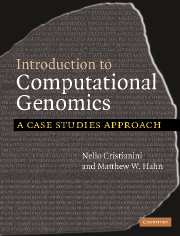Book contents
- Frontmatter
- Contents
- Preface
- Prologue: In praise of cells
- Chapter 1 The first look at a genome
- Chapter 2 All the sequence's men
- Chapter 3 All in the family
- Chapter 4 The boulevard of broken genes
- Chapter 5 Are Neanderthals among us?
- Chapter 6 Fighting HIV
- Chapter 7 SARS – a post-genomic epidemic
- Chapter 8 Welcome to the hotel Chlamydia
- Chapter 9 The genomics of wine-making
- Chapter 10 A bed-time story
- Bibliography
- Index
Chapter 2 - All the sequence's men
Gene finding
Published online by Cambridge University Press: 05 June 2012
- Frontmatter
- Contents
- Preface
- Prologue: In praise of cells
- Chapter 1 The first look at a genome
- Chapter 2 All the sequence's men
- Chapter 3 All in the family
- Chapter 4 The boulevard of broken genes
- Chapter 5 Are Neanderthals among us?
- Chapter 6 Fighting HIV
- Chapter 7 SARS – a post-genomic epidemic
- Chapter 8 Welcome to the hotel Chlamydia
- Chapter 9 The genomics of wine-making
- Chapter 10 A bed-time story
- Bibliography
- Index
Summary
The human genome sweepstakes
In May of 2003 it was announced that Lee Rowen of the Institute for Systems Biology in Seattle, Washington was the winner of GeneSweep, an informal betting pool on the number of genes contained in the human genome. Rowen's guess of 25,947 won her half of the $1200 pool and a signed copy of James Watson's book, The Double Helix. GeneSweep had been created in 2000 by Ewan Birney of the European Bioinformatics Institute just as large pieces of the genome were being completed; because of the increasing amount of sequence becoming available, the cost of bets rose from $1 in 2000, to $5 in 2001, to $20 in 2002. One of the most surprising things about Rowen's winning guess was that it was almost certainly 3,000 genes off the mark – above the true number of genes! Researchers had placed wagers on figures as high as 300,000 genes, with only three sub-30,000 guesses. This number of genes put humans below the two plants that have been sequenced and barely above the worm, C. elegans.
Genes and proteins
Gene finding and sequences
Statistical hypothesis testing
Though the draft sequence of the human genome was published in 2001, nailing down exactly how many genes it contained turned out to be a tricky proposition.
- Type
- Chapter
- Information
- Introduction to Computational GenomicsA Case Studies Approach, pp. 22 - 37Publisher: Cambridge University PressPrint publication year: 2006



